
7-27: Huawei 1H16 smartphone shipment 60.56mln units; LeEco acquires Vizio; Tsinghua Unigrou reportedly to merge with XMC; etc.
|
Chipset |
| MediaTek Helio X30 will be manufactured by TSMC using 10nm manufacturing process. It features deca-core consisting of 2×A73 (2.8GHz), 4×A53 (2.2GHz) and 4×A53 (2GHz) cores. It also supports 4 channels LPDDR4 RAM (up to 8GB RAM storage modules), and UFS2.1 technical standards. (CN Beta, Gizmo China) |
| GlobalFoundries reportedly has been a major disappointment for years as they struggled with AMD silicon, often being their decelerator. Thus, AMD officially diversifies 14nm manufacturing with Samsung. (TechNews, Forbes) |
| Analog Devices Inc. (ADI) will acquire rival Linear Technology Corp. in a cash and stock deal worth about USD14.8 billion. (CN Beta, EE Times, Bloomberg, WSJ, NASDAQ) |
|
Touch Display |
| LG Display has announced that the company plans on investing USD1.75 billion towards flexible OLED screens. (Ubergizmo, Reuters, WSJ, iFeng) |
| LG Display has announced that its 2Q16 operating profit fell 91% from a year earlier, as weak demand for gadgets such as smartphones hurt panel prices, though the result was in line with expectations. The April-June profit was KRW44 billion (USD38.77 million). (Business Insider, Investing, Reuters, iFeng, Korea Herald) |
| Apple iPhone 7 reportedly may not include a physical home button, instead adopting a touch-sensitive “3D Touch” home button. (Ubergizmo, Mac Rumors, CN Beta) |
|
Memory |
| Tsinghua Unigroup Ltd. has reportedly merged its memory chipmaking operations with Chinese government-run XMC’s, creating one of the country’s largest manufacturers of semiconductors. The newly merged entity is called Yangtze River Storage Technology. (Deal Street Asia, Bloomberg, WSJ, CN Beta) |
| Intel 12” fab in Dalian has been put into operation for the manufacture of non-volatile random-access memory (NVRAM) chips. Intel has invested a total of USD5.5 billion to convert the Dalian fab for memory chip production. Intel expects initial production of the 3D NAND technology in Dalian in the 2H16. (TechNews, Digitimes, press) |
| SK Hynix has announced consolidated revenues increased 8% sequentially to KRW3.94 trillion (USD3.47 billion) in the second quarter of 2016 thanks to “increased product shipments beyond expectation, courtesy of memory demand recovery.” However, due to falling prices of memory chips, SK Hynix’ operating profits decreased 19% on quarter. (TechNews, Digitimes, press) |
|
Sensory |
| Mobileye, a leading maker of software and components for automated driving systems, will not supply the next generation of its technology to Tesla Motors Inc. (CN Beta, Forbes, Re/Code) |
|
Smartphones |
| Apple has released its Q3 2016 (April through June 2016) financials, device sales across all 3 main product categories falling over the past year. iPhone sales saw the steepest decline year over year, with 40 million sold. Apple reported earnings of USD7.8 billion, a 27% decline from last year’s USD10.68 billion. (Apple Insider, Apple Insider, WSJ, CN Beta, CN Beta, CNET, Engadget, The Verge, Apple) |
| In its fiscal 2016 third quarter ended 25 June 2016, revenues from Apple’s services businesses, including iTunes, iCloud, Apple Music, Apple Pay, Apple Care and the various App Stores, grew 19% YoY to hit a new June quarter record of USD6 billion. Of note, App Store revenue reached a new all-time high after finishing up 37% for the quarter. (CN Beta, Apple, Apple Insider, ZOL, Sina) |
| Huawei Technologies Co Ltd grew its 1H16 smartphone shipments 25% to 60.56 million units. Its consumer business unit raked in CNY77.4 billion (USD11.6 billion) in revenue in the first six months, up by 41% compared with a year earlier. (CN Beta, Gizmo China, Tencent, iFeng, China Daily, Android Central) |
| According to Canalys, global shipments reached over 330 million units, with Samsung leading the market with shipments around 80 million units. Huawei has cemented its lead in the Chinese market, shipping just over 19.1 million smartphones. (Canalys 1, press, Canalys 2, press, CN Beta) |
| Taiwan-based ODMs / OEMs shipped 12.06 million smartphones in 2Q16, slipping 13.5% on quarter and 43.5% on year, according to Digitimes Research. (Digitimes, press) |
| Gionee M6 / M6 Plus is announced targeting professionals with “secure element” chips: M6 – 5.5” FHD Super AMOLED display, MediaTek Helio P10 MT6755 processor, 13MP + 8MP cameras, 4GB RAM, 64/128GB storage, LTE, dual-SIM, 5000mAh battery. M6 Plus – 6” FHD Super AMOLED display, MediaTek Helio P10 MT6755 processor, 16MP + 8MP cameras, 4GB RAM, 64/128GB storage, LTE, dual-SIM, 6020mAh battery. (GizChina, Digital Trends, BGR, CN Beta, Phone Arena) |
|
Tablets |
| Sosoon C96 entry-level tablet is announced – 9.6” 1280×800 IPS LCD display, MediaTek MT6580 processor, 2MP + 2MP cameras, 1GB RAM, 16GB storage, Android 5.1, 2G/3G, 4400mAh battery. (GizChina) |
|
Wearables |
| HTC is expected to face increasing competition from other brand vendors in the VR market in 2H16. HTC reportedly has placed more orders for parts and components from upstream suppliers recently and is expected to be able to ship up to 700,000 units of its HTC Vive in 2016. (Digitimes, press) |
| The Intel Remote EyeSight, a set of head-worn AR smart glasses, is built around the idea of remote collaboration. It is a product that uses Intel’s Collaboration Suite for WebRTC video capabilities to “transform Intel’s enterprise collaboration experiences with secure, cost-effective, hands-free and augmented reality technologies”. (IT World, PC World, CN Beta) |
| Apple CEO Tim Cook confirmed investments into augmented reality solutions, saying the nascent platform holds “huge” potential. (Ubergizmo, Apple Insider, Mac Rumors, CN Beta) |
| According to Digitimes, upstream component makers have seen weaker-than-expected orders for tablet and wearable products since the early 1H16 and the issue is expected to continue in 2H16 and will hurt the makers’ revenue performances in 2016. (Digitimes, press) |
|
Internet of Things |
| Chinese tech firm LeEco announced an agreement to buy American TV-maker Vizio for USD2 billion. The move joins one of the largest manufacturers of cheap televisions in the U.S. with a company that few have heard of outside of Asia. (CN Beta, Android Authority, MSN, WSJ, USA Today, Forbes) |
| LG Uplus, one of Korea’s big three telecommunications companies, has launched an IoT helmet designed to help mitigate the risks and dangers laborers are exposed to at construction sites. It is equipped with an LTE modem, camera, LTE-based communications module, and a GPS chip. (Far East Gizmos, Korea Bizwire) |












